Abstract
This paper aims to examine the publication metrics of literature related to the influential aspects of ESG (environmental, social, and governance), SRI (socially responsible investing), ethical, and impact investing on the portfolio and financial performance literature. It also seeks to identify major patterns and core themes in this topic and draw lessons from the past literature for future directions. Data from the SCOPUS database were used in this study. The ‘biblioshiny’ R package, also known as ‘bibliometrix 3.0’, was employed to conduct bibliometric analysis, utilising mapping and clustering techniques on 260 articles, in order to distil the comprehensive knowledge and identify emerging trends in ESG, SRI, ethical, and impact investing. The thematic map classified the ESG, SRI, ethical, impact investing and performance relationship themes into four categories of themes: niche themes (SRI, engagement and ESG), motor themes (corporate financial performance, corporate social performance, ESG, ESG factors, sustainability, performance, integrated reporting, gender diversity, and board size), emerging or declining themes (social responsibility, environmental performance, socially responsible investment, ethical investment, and SRI), and basic or transversal themes (financial performance, corporate social performance, ESG performance, environmental, social, and governance). Socially responsible investing, engagement, and ESG imply a position between niche themes and a highly developed topic/emerging or a decreasing theme, while the impact of COVID-19 on sustainability and financial performance implies a position between a highly developed topic/emerging or decreasing theme and a basic theme. The findings contribute to the enhanced understanding of ESG, SRI, ethical, impact investing and performance, which are crucial for an efficient capital market in promoting sustainability and sustainable development. The study offers vital practical implications and future research directions.
1. Introduction
Although there are important differences, the terms environmental, social, and governance (ESG), socially responsible investing (SRI), and impact investing are often used interchangeably. Besides typical financial indicators, ESG considers the company’s ESG activities (Zhou 2019). Additionally, SRI entails selecting or rejecting assets based on certain ethical standards (Zhou 2019). The SRI concept or responsible investment (RI) has emerged to be highly relevant among numerous investors in recent decades and gained increasing attention within academic literature (Derwall et al. 2011; Sievänen et al. 2013). As stated by the European Social Investment Forum (Eurosif 2016), SRI can be comprehended as a long-term-oriented investment method that targets integrating ESG factors into decisions concerning investments. In the economics literature, corporate social responsibility (CSR) is another commonly used term for ESG factors (Liang and Renneboog 2020; Gillan et al. 2021). The Principles for Responsible Investment (PRI) (2015) outlined that ESG investment is an approach that focuses on improved risk management and better sustainability in long-term returns. An increasing number of investors are attempting to make organisations act responsibly besides only delivering financial returns.
The bibliometric analytical technique (Gao et al. 2021; Arslan et al. 2022; Bosi et al. 2022; Ellili 2022; Galletta et al. 2022; Khan 2022; Passas et al. 2022; Rodriguez-Rojas et al. 2019; Senadheera et al. 2022) utilised in the present paper is proposed to examine the research on ESG. Galletta et al. (2022) conducted a bibliometric analysis on 271 publications retrieved from the Web of Science (WOS) to examine intellectual development, authors’ characteristics, and ESG-related manuscripts in the banking industry and assess research trends. Nevertheless, the bibliometric analysis conducted only included publications that dealt with ESG performance within the banking sector. Bosi et al. (2022) only examined publications that discussed ESG performance, specifically in the banking industry, using bibliometric analysis. In contrast, Khan (2022) and Ellili (2022) conducted bibliometric analyses that focused on publications about ESG disclosure and firm performance. Passas et al. (2022) analysed 228 publications related to ESG controversies by using bibliometric analysis to examine the key characteristics and ESG controversy trends in the European market. Gao et al. (2021) used various bibliographic approaches, including co-occurrence analysis and bibliographic coupling, to ascertain the publishing trend of ESG research from 1980 to 2020. The authors used SCOPUS data from 314 publications that included ESG-related material, although the field is vast. There is a conspicuous absence of literature reviews that have endeavoured to investigate the burgeoning realm of ESG without imposing excessively restrictive constraints. For instance, Gao et al.’s (2021) review evince that overly rigorous criteria are employed to cull the corpus of literature for review to a practicable extent.
Thus, the present study considerably expands on Gao et al.’s (2021) study by eliciting insights that they were unable to offer due to the intrinsic restriction of keywords chosen, which reduced the number of results available for their analysis. The present study also expanded Widyawati’s (2020) study by evaluating ESG, SRI, ethical, and impact investing publication data from 2013 to 2022 by utilising bibliometric analysis as opposed to systematic literature reviews. The bibliometric analysis, through visualisation and quantitative bibliometric tools, is viewed as complementary to the qualitative systematic literature review as it paints a picture of the state of the art in a specific research line (Liao et al. 2018). According to Gao et al. (2019), bibliometrics is attractive as it enables researchers to examine research topics by analysing citations, co-citations, geographical distribution, and word frequency. It assists in drawing insightful conclusions, including the most prominent institutions, noteworthy authors, and influential journals. It offers a visual on knowledge development, the latest trends in research, and future directions regarding the topic.
The aim of the study was to conduct a bibliometric analysis of all publications related to the influence of ESG, SRI, ethical, and impact investing on portfolio and financial performance on SCOPUS. Bibliometric analysis, which is a quantitative review technique known for its objectivity and effectiveness, was employed due to its suitability in analysing fields with a large corpus of articles (Pattnaik et al. 2020; Donthu et al. 2021; Paul and Bhukya 2021). A comprehensive examination of research progress could provide a meticulous assessment of various scientific aspects inherent in ESG, SRI, ethical, impact investing and performance in this context. Among the parameters utilised are the document type (all), publication language (English), and subject areas (accounting, business, economics, econometrics, finance, management, and social science). The study also examines the author, the publication models, thematic category distribution, the author’s keyword distribution, publication country, and most frequently cited articles. The diverse rankings of bibliometric analysis emphasise the multidimensional nature of the scientific impact. Moreover, this type of analysis provides a notable illustration of how big data analytics and machine learning can be effectively utilised to facilitate academic research in two crucial ways:
- (1)
- The search for big data through bibliometric analysis is conducted on SCOPUS, an AI-powered scientific database. The database employs specified keywords for supervised machine learning, a subset of AI, to obtain extensive bibliometric data on articles related to the influence of ESG, SRI, ethical and impact investing on portfolio and financial performance.
- (2)
- Bibliometric analysis, as a form of big data analysis, is characterised by its multifaceted nature, which includes various dimensions such as keywords, authorship, journal, institution, and country. The analysis also involves different formats, such as words and numbers, and it deals with a large-scale dataset comprising thousands of data points across multiple facets of 1319 articles. To uncover latent relationships and major themes, unsupervised machine learning techniques, which are a subset of artificial intelligence, are utilised to analyse the data.
Thus, this study attempted to synthesise the literature related to the influence of ESG, SRI, ethical and impact investing on portfolio and financial performance to determine the latest trends, key themes, authors, and influential journals in recent years. In response to recent demands for more comprehensive research on this subject, this study seeks to take a broader approach and answer the following three research questions:
RQ1. What are the most influential aspects of the influence of ESG, SRI, ethical and impact investing on the financial and portfolio performance literature?
RQ2. What are the major patterns and core themes in this topic?
RQ3. What lessons can be drawn from the past literature to plan for the future, and what future agendas can be set?
In various respects, the study strengthens current research in ESG, SRI, ethical and impact investing, and business literature. Initially, big data technology termed bibliometric analysis was utilised to offer a comprehensive synthesis of this fragmented literature. Additionally, the study emphasises significant milestones in this field of study, such as notable publications, authors, journals, and institutions. This analysis also recognises the prevailing research trends and themes in the discipline. Finally, the research offers managers, policymakers, and regulators recommendations for the impact of ESG, SRI, ethical and impact investing on financial and portfolio performance. Lastly, the study suggests ways for researchers to broaden the scope of their research.
The article is structured as follows: Section 2 presents the materials and methods used in the study. Section 3 investigates the significant attributes of the research. Subsequently, Section 4 discusses the conceptual framework of the study. Section 5 provides an analysis of the findings, while Section 6 presents a summary of the study.
2. Materials and Methods
2.1. Five Steps of Bibliometric Analysis
This article follows a bibliometric workflow, which is a five-step method proposed by Silvente et al. (2019). Figure 1 depicts the five phases of the bibliometric study. This research was conducted using an objective and dependable approach to cover three levels of analysis: sources, authors, and documents. Initially, the research concentrated on determining the relevance of issues associated with each level. In this context, relevance has been defined as the most productive or referenced item, depending on the unit of analysis. Second, knowledge structures were determined using various bibliometric methodologies. Specifically, conceptual structures were examined in terms of major topics and trends, intellectual structures regarding how individual works affect the scientific community, and social structures concerning author–country cooperation. The study was conducted using the bibliometric R-Tool (Aria and Cuccurullo 2017). The recently released R package enables a highly comprehensive bibliometric analysis through utilising specialised tools for bibliometric and scientometric quantitative research.
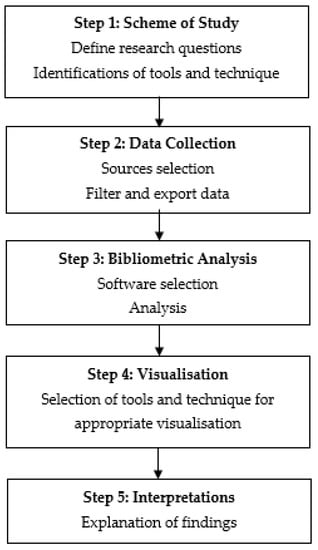
Figure 1.
Process of bibliometric analysis. Source: Arslan et al. (2022).
In this context, R is one of the most powerful and versatile statistical software environments available, offering a path to involvement through open source. Thus, R is a collection of integrated software programmes for data processing, computation, and visualisation. In the case of bibliometrics, connecting it with other pertinent software packages is feasible. For example, the ‘biblioshiny’ package in RStudio is utilised to enhance the paper’s content analysis. The processes adopted to conduct the bibliometric analysis included data collecting and descriptive and bibliometric analysis by level.
2.2. Scheme of Study
Numerous concerns posed by the present global environment have to be addressed. The present study attempts to address RQ1 (What are the most influential aspects of the influence of ESG, SRI, ethical and impact investing on financial and portfolio performance literature?) by conducting a descriptive analysis and identifying key sources, publications, authors, countries, and affiliations within the relevant publications. Net publications (NP) per year, total citations, and source influence were used for authors and core sources. In order to categorise the primary sources, Bradford’s Law was employed to divide the sources into three zones. Area 1, or the nuclear zone, is the most active zone, followed by Zone 2, which is moderately active. Subsequently, compared to Zone 1 and Zone 2, Zone 3 is barely productive (Viju and Ganesh 2013). The study suggests the top countries and affiliations according to the frequency of publications and total citations.
To address RQ2, co-occurrence maps, thematic maps, and thematic evolution were utilised to detect significant patterns and topics within the literature. The authors’ keywords and system-generated keywords (known as “keywords plus”) from the chosen works were employed to recognise research streams and themes within the bibliometric tool called “biblioshiny”, which is provided by the R-programme. The keywords given by the author in an article indicate the study’s important content. The co-occurrence and intensity analysis of keywords in a research area allows for the discovery of research hotspots and frontiers. The affinity of certain phrases appearing together to suggest the field’s conceptual structure is shown by keyword co-occurrence analysis. The clustering analysis of keywords produces a map that represents the network of interrelationships between the phrases (Zupic and Čater 2015). The study’s future research plan is developed on the findings for RQ3.
2.3. Objectives, Tools, and Technique
This paper conducts a bibliometric analysis by adopting a mapping and clustering analysis on topics related to the influence of ESG, SRI, ethical, and impact investing on portfolio and financial performance. The web-specific R package ‘biblioshiny’ (also known as ‘bibliometrix 3.0’) was utilised to explore influential aspects, identify patterns and core themes, and draw lessons from the past literature for future directions. The primary objective is to use descriptive analysis to identify the most significant factors by utilising various research tools accessible through the biblioshiny GUI, including Bradford’s Law, global citation, h-index, g-index, and m-index. The second objective is to determine the primary sources and themes of the study, which will be accomplished through the scientific mapping approaches of conceptual structure and authors’ keywords and keywords plus, using them as input data. Once objectives 1 and 2 are addressed, the study then offers a brief interpretation and recommends future study priorities.
2.4. Composing of Bibliometric Data
This analysis chose to utilise one database, SCOPUS, which is a larger database than WOS. The additional coverage is beneficial for mapping smaller research topics implicitly covered by the former (Zupic and Čater 2015). In order to choose which papers to include in the study, the procedures involved in data synthesis must be identified. As per previous prior bibliometric studies (Arslan et al. 2022; Bosi et al. 2022; Ellili 2022; Gao et al. 2021; Passas et al. 2022; Khan 2022; Senadheera et al. 2022), the SCOPUS database was employed to choose the related literature. The final search query is (TITLE ABS-KEY (“ESG” OR “environment*, social, and governance” OR “Sustainab*” OR “social responsible invest*” OR “impact invest*” OR “ethic* invest*” AND “financial performance” OR “portfolio performance”) (Figure 2). On 31 March 2023, the search was performed on the SCOPUS database. During the initial search, 1377 publications were found that appeared to be related to the topic being studied. Out of the initial pool of publications, 1117 were removed as these papers did not meet the specified criteria such as the contents being unrelated to the topics, duplications, and not encompassing all aspects of ESG, SRI, ethical investing and impact investing, along with financial and portfolio performance. This process resulted in a final set of 260 publications. According to studies that have analysed the linked subject, the most relevant publications on the topic which were chosen include 260 from 159 sources from 2013 to 2022. Since the focus of this article is to assess the latest trend of ESG, SRI, ethical and impact investing research, the time span was limited to the previous ten years. The discipline category is confined to accounting, business, economics, econometrics, finance, management, and social sciences.
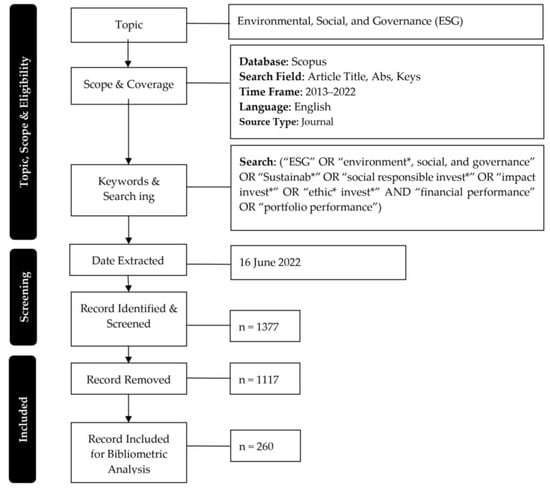
Figure 2.
Flow diagram of the search strategy. Source: Zakaria et al. (2020).
The subsequent stage was to analyse the indications in the data after cleansing the data from the literature. In bibliometric analysis, performance evaluation, and scientific mapping, two main types of indicators (Durieux and Gevenois 2010) are commonly utilised in the literature. The number of citations and publications are used to assess productivity and impact in performance analysis. The objective of scientific mapping is to represent information from the literature in a clear and visual manner that highlights the research dynamics and structure of the field.
2.5. Bibliometric Analysis and Visualisation
Biblioshiny is an R-programme designed for individuals without coding experience, which offers comprehensive scientometric and bibliometric analysis options that are categorised into sources, records, authors, and conceptual, social, and intellectual structures (Moral-Muñoz et al. 2020). The descriptions of the datasets are supplied in bibliometric style to help clarify the knowledge structure of the research linked to ESG, SRI, ethical and impact investments. All linked articles that matched the search query were assessed using the criteria listed in Table 1. The criteria include that the time spans from 2013 to 2022, covers 260 articles from 159 publications, with 262 keywords plus and 704 authors’ keywords. The average number of citations per document is 26.55. On average, each document in the dataset has been cited about 27 times by other scholarly works. This indicates that the documents in the dataset are fairly well cited and have likely had some impact in the scholarly community. The average number of citations per year per document is 5.392. This means that, on average, each document in the dataset has received about 5 citations per year since it was published. This metric provides a sense of how frequently the documents in the dataset have been cited over time and suggests that they continue to be relevant and influential in the field. The dataset includes 14,731 references, which indicates that the documents draw on a wide range of prior research and scholarship in the field. The dataset contains a total of 624 different authors, who collectively appear 685 times as authors or co-authors of the documents in the dataset. This means that there are 624 unique authors who have contributed to the documents in the dataset, and some of them have contributed to multiple documents. This indicates that there is a relatively diverse set of contributors to the field, with many individuals contributing to multiple documents. The collaboration index is 2.81, indicating that, on average, documents in the dataset have just under three co-authors. Overall, these findings suggest that the dataset is a diverse and well-cited collection of research on the topic of interest.

Table 1.
Descriptive characteristics.
Figure 3 depicts the yearly output of ESG, SRI, ethical, impact investing and performance publications. The publications were significantly low from 2013 to 2015. Nevertheless, there was a sharp increase in the number of articles published in the subject areas in 2016 and it continues to grow to 93 articles in 2022. Figure 4 depicts a three-field (from left to right, keywords, nations, and their affiliation) examination of research on the link between financial and portfolio performance and ESG, SRI, impact investing, and ethical investing. In this literature, the most notable affiliations are India, the United States (USA), Malaysia, Italy, Germany, and France. Financial performance is the most-used keyword (for example, corporate financial performance (CFP), CSR, financial performance, firm performance, sustainability, and sustainable development). Universities from Malaysia and India are the most contributing affiliations, such as Universiti Teknologi Mara, Christ—Deemed to be University, followed by other high-contributing affiliations, such as the Nord University, Universiti Tenaga Nasional, Universiti Utara Malaysia, and the Bucharest University of Economic Studies.

Figure 3.
Annual publication trends.
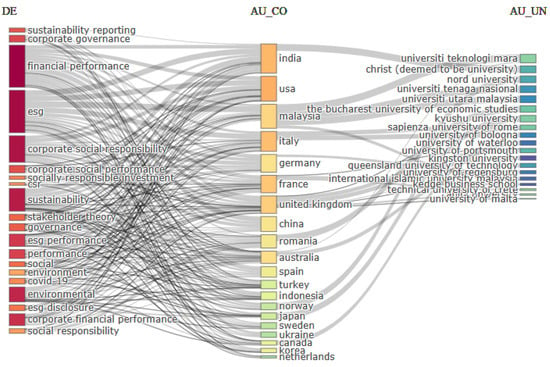
Figure 4.
Three-field analysis of “ESG” OR “environment*, social, and governance” OR “Sustainab*” OR “social responsible invest*” OR “impact invest*” OR “ethic* invest*” AND “financial performance” OR “portfolio performance”.
3. Influential Aspects of ESG, SRI, Impact Investing, and Ethical Investing
3.1. Core Journals
The source impact and Bradford’s Law were employed to identify the most important journals that publish the ESG, SRI, ethical investing, impact investing, and performance literature. According to Table 2, the Bradford rule categorises the journal into three zones. Zone 1, also known as a nuclear zone, is immensely valuable. Opposed to Zone 1, Zone 2 is slightly more productive. According to Bradford’s rule in Zone 1, the top-ranked journal is Sustainability (Switzerland), which has published 215 articles on ESG, SRI, impact investing, and ethical investing. Table 3 displays the ranks of publications based on the h-index, m-index, and g-index, total citations, net publications (NP), and the publication year (PY start). Ad-ditionally, top affiliations are indicated based on the frequency of publication and cita-tions.

Table 2.
Journal Rankings.

Table 3.
Top Journal According to Source Impact.
Figure 5 depicts the increase in publishing by leading journals. A downward trend was observed between 2013 and 2015. A significant surge in publications linked to ESG, SRI, impact investment, and ethical investing has been shown since 2016. After 2016, there was an increase in the number of articles in Sustainability, Journal of Cleaner Production, and Business Strategy and Environment.
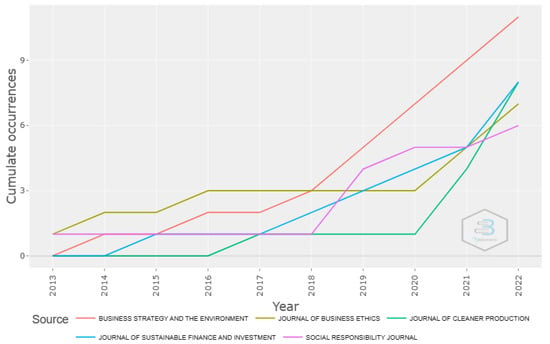
Figure 5.
Source Growth.
3.2. Core Journal Articles
This section highlights the top articles in ESG, SRI, ethical investing, impact investing, and performance journals. Table 4 lists the top twenty most-cited articles on the subject globally. In the first research, Saeidi et al. (2015) published the most referenced paper with 640 citations. They explored the direct association between CSR and business performance and three likely mediators in the relationship between CSR and firm performance. They discovered that CSR has a positive influence on business performance since it improves competitive advantage, reputation, and customer happiness. These data imply that CSR might indirectly promote corporate performance by strengthening reputation and competitive advantage while increasing consumer satisfaction. The meta-analysis on ESG criteria and CFP is the second most significant article on the list, with 478 citations. Friede et al. (2015) conducted a meta-analysis of over 2000 empirical research on ESG parameters and CFP. The results demonstrate that the business case for ESG investment is empirically sound. Around 90% of research discovers a non-negative ESG–CFP relationship. Most significantly, most of the research indicates good results.

Table 4.
Most Globally Cited Article.
3.3. Core Words
The most used terms in the ESG, SRI, impact investing, and ethical investing literature are stated in Table 5. The authors’ most frequent keywords include “financial performance”, “ESG”, “corporate social responsibility” and “sustainability”, having the highest occurrence of 70 times.

Table 5.
Most-frequent words.
Figure 6 depicts the word cloud created using keyword addition. Words that often recur in the text have greater font sizes. In the literature on ESG, SRI, impact investing, and ethical investing, the terms “financial performance”, “finance”, “financial system”, and “industrial performance” appear most often. Consequently, these terms are the most often used terms, followed by stakeholders, environmental management, governance approach, supply chain management, stakeholders, and profitability.
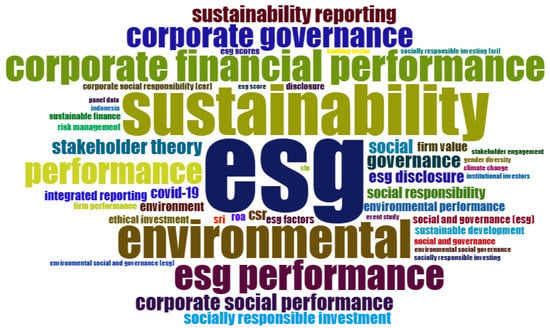
Figure 6.
Word cloud.
In addition to the word cloud, Figure 7 displays the evolution of terms in literature across time. As seen in the graph, the term “sustainability” started to grow in popularity in 2016. The keyword “sustainable development” has also been on the rise since 2016. Figure 6 shows how keywords evolve over time using a lowess smoothing approach. There was a significant increase in industry-related issues in 2017.
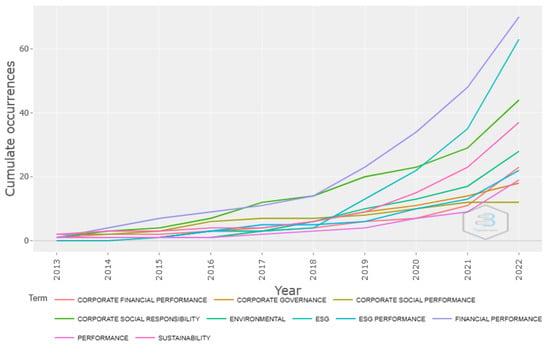
Figure 7.
Word growth over time.
4. Conceptual Framework
4.1. Co-Occurrence Network
Figure 8 depicts the co-occurrence network of the authors’ terms. The illustration is from the R package ‘biblioshiny’ (‘bibliometrix’). The keyword co-occurrence network exposes three separate streams of ESG, SRI, impact investing, and ethical investing and categorises this literature into three different clusters: green, red, and blue.
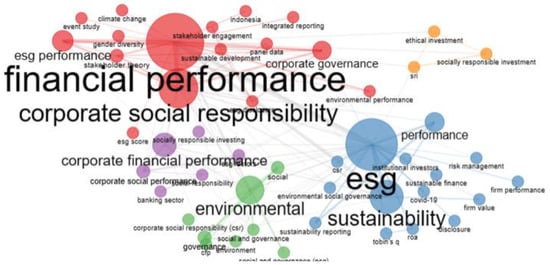
Figure 8.
Co-occurrence network.
The red and purple cluster focuses on the following research areas: the impact of sustainability on firm performance, including environmental performance, social performance, environmental sustainability, and sustainable development. According to the corporate perspective, companies that place a high value on ESG and perform well outperform their rivals in ESG risk management. In addition, organisations that do well in ESG have a long-term and consistent positive association between ESG performance and financial success. In developing countries, ESG investing techniques might provide large excess profits. Numerous studies in this cluster have investigated environmental performance and its impact on European listed firms’ financial performance (Wamba 2022), Serbia (Hanić et al. 2021), and China (Chang et al. 2021). Friede et al. (2015) reviewed over 2200 relevant papers and discovered that over 2100 empirical studies (particularly company-centric empirical studies) demonstrated a favourable association between ESG and CFP.
The blue cluster’s issues were on ESG, such as ESG reporting, sustainability reporting, integrated reporting, stakeholder engagement, sustainability performance, company value, and governance. The disclosure of environmental, social responsibility, and corporate governance (environment, social, and governance, or ESG) information is referred to as ESG disclosure. Businesses have made efforts towards internal improvement by implementing sustainable and socially responsible policies and reporting them in order to stay competitive, as the demands for corporate transparency and accountability for ESG reporting have increased dramatically over the last few decades. In addition to non-financial reporting, corporate sustainability reports (CSR), CSR disclosures (CSRD), and economic, governance, social, ethical, and environmental (EGSEE) reports have all been used to express the idea of ESG reporting (Rezaee 2016). ESG factors are increasingly a crucial component of many finance providers’ investment decisions. Sustainable investing ideas have already been implemented by several conventional fund managers (Van Duuren et al. 2016). Besides financial performances, ESG performances are one of the important factors that effectively can encourage investors.
The green cluster focuses on the study of CSR, which includes the social, financial, and environmental aspects of company performance and corporate governance. In fact, CSR and ESG vary from one another in a few ways. Accordingly, CSR prioritises the needs of a variety of stakeholders and organisations, and ESG has emerged as a crucial tenet of CSR (Gao et al. 2021). Primarily, ESG begins from the viewpoint of capital market investors, concentrating on the connection between corporate social performance and shareholder returns (Gao et al. 2021). The ESG application scenarios concentrate on the capital market, particularly between investors and listed firms. In contrast, CSR application scenarios are rather wide and may emerge in sectors including company supply chain management, brand marketing, community communication, and employee management (Gao et al. 2021).
4.2. Thematic Map
This research has defined a few study topics to help readers comprehend the results. The developed themes can be integrated into a strategic diagram to assess the importance and conception of the study subject. The analysis of the thematic map in this research offered valuable insights into the trends and patterns within the literature on ESG, SRI, ethical, and impact investing. By examining the centrality and density of different themes, the study identified the varying degrees of importance, development, and relevance of these themes within the field. Figure 9 displays the thematic map based on density (y-axis) and centrality (x-axis). The centrality of the selected theme is a gauge of its importance. In contrast, the density of the selected subject is used to gauge its development. Furthermore, the subject’s relevance within the broader field of inquiry may be inferred from its centrality, and the subject’s development can be gauged from its density. The author’s keywords are those that the original authors gave at the time the text was published. It is possible to draw attention to the many themes within a specific area by using the clustering method on the term network. A strategic or thematic map is a specific plot that may show each cluster or topic.
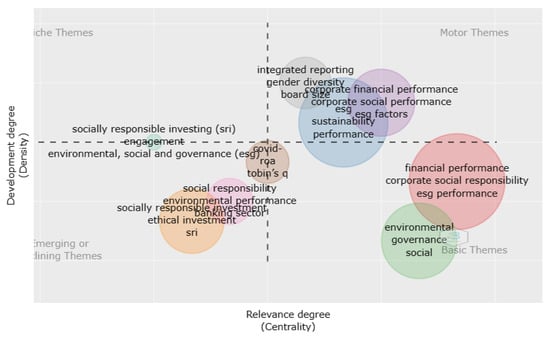
Figure 9.
Thematic map.
There are four sections to the graph. Themes that appear in the lower left corner are those that are emerging or waning. These fresh ideas can emerge and advance the subject of study, or they might disappear. The thematic map’s bottom right corner contains the fundamental or transversal topics. Although having a modest density, these motifs are immensely important. Based on the information provided, the ideas of corporate financial performance, corporate social performance, ESG, and ESG factors are located in the top right corner of the thematic map, which is known as the motor theme. This suggests that these topics have received significant attention and have been extensively studied in the context of ESG, SRI, ethical, and impact investing. Researchers can further explore these themes to gain deeper insights into their relationship with financial and portfolio performance. Socially responsible investment (SRI), engagement, and ESG are in the upper left corner of the thematic map called the niche theme, representing the well-developed concepts in the literature on ESG, SRI, and ethical and impact investing and performance. These themes have received considerable attention and have been extensively explored within the specific context of ESG, SRI, and ethical and impact investing. Researchers can delve into these areas to investigate the effectiveness of engagement strategies or the impact of ESG practices on company performance.
The terms “socially responsible investment”, “ethical investment”, “environmental performance”, and “SRI” may be found in the lower left corner under the heading “highly developed topic/emerging or decreasing theme”. While these themes have been extensively studied in the past, their decreasing density suggests a potential shift in research focus or emerging interest in other areas. Researchers can explore the reasons behind these trends and investigate the evolving dynamics within these themes. Financial performance, corporate social responsibility, ESG performance, and environmental, social, and governance in the sustainability literature are the less-developed and basic concepts present in the lower right corner named “basic or transversal theme”. These themes exhibited lower centrality and density, indicating the need for further research and development. Researchers can focus on exploring the integration of ESG considerations into investment decision-making processes or assessing the long-term implications of environmental and social factors on financial performance. More study on these topics in the particular situation described by the fundamental theme is required to bring value to this subject. Difficulties that are in a hybrid situation, such as two quadrants, may also be detected. They are socially responsible investing, engagement, and ESG, which imply a position between niche themes and highly developed topic/emerging or decreasing theme, while the impact of COVID-19 on sustainability and financial performance such as Return on Assets (ROA), and Tobin’s Q imply a position between highly developed topic/emerging or decreasing theme and basic theme.
4.3. Thematic Evolution
Thematic evolution (Figure 10) displays the history of the literature through time and the theme diagram. Keywords and thematic evolution are used to show the history and development of themes. Thematic development is accomplished by the usage of ‘biblioshiny’ and the division of thematic evolution into two sections. The first portion ranges from 2013 to 2019. The first phase of this research focused on the impact of sustainability and ESG on financial performance and company financial performance. The performances of sustainability, ESG, and productivity have been given enormous weightage in the final time segment covering 2021 to 2022 in the sustainability disclosure literature.
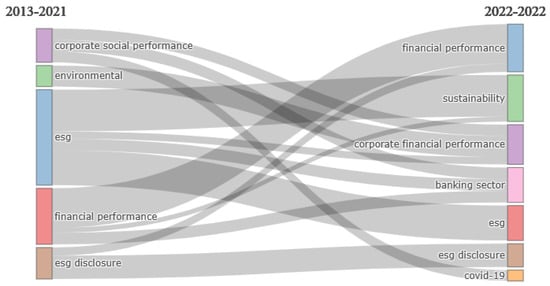
Figure 10.
Thematic evolution.
5. Discussions and Future Research Directions
The present study offers numerous insights into ESG, SRI, ethical and impact investing, and performance literature. Initially, in response to the research question, the following influential factors were discovered:
- (1)
- The recent years, 2021–2022, had the largest number of publications. The findings suggest that ESG, SRI, ethical investing, impact investing, and performance literature remain a potential concern for ESG, SRI, ethical investing, and impact investing scholars seeking additional study contributions.
- (2)
- Business Strategy and the Environment, Journal of Cleaner Production, and Journal of Sustainable Finance and Investment are the primary avenues for publishing additional studies on this topic.
- (3)
- The most significant articles on this subject were recognised as Saeidi et al. (2015) and Friede et al. (2015). According to Saeidi et al. (2015), the link between CSR and firm performance is more complicated than prior research has demonstrated. As a result, the neglected sustainable competitive advantage as a result of customer happiness and reputation is thought to be another effective mediator in the relationship. Friede et al. (2015) examined over 2200 independent studies on the ESG–CFP link. According to the findings, 90% of research reveals a non-negative ESG–CFP relationship. Most significantly, the majority of research indicates good results. The study’s recent citations may help the researchers contribute increasingly advanced research in this area.
- (4)
- India is the most active researcher in this subject. Future studies are recommended to undertake further cross-country research using a panel of organisations from high- and low-carbon-emitting nations.
Second, the answers to the second research question on the most typical trends in this area bring up new possibilities for future research. The first trend in ESG, SRI, and ethical and impact investing is financial performance, followed by sustainability and CSR. Nonetheless, earlier research has been confined to a particular context, for instance, in the USA (Wamba 2022), China (Zhang et al. 2022), and Serbia (Hanić et al. 2021). As a result, it is advised that future studies expand this study in cross-country situations with varying economic and political backgrounds. Finally, the results show that new themes are developing, including SRI and social responsibility. Recently, much research has been conducted on ESG and intellectual capital. Future studies will add to these rising cross-national issues and novel research designs.
This study offers valuable practical implications and outlines compelling future research directions for this discipline. Future research can focus on investigating the effectiveness of engagement strategies in driving positive changes in companies’ ESG practices. Furthermore, examining the evolving role of global events, such as COVID-19, in shaping the relationships between ESG, SRI, ethical and impact investing, and financial performance offers opportunities for deeper insights. Assessing the long-term implications of gender diversity and board size on company performance and sustainability presents another area of research that holds significant potential. Additionally, studying the integration of ESG considerations into investment decision-making processes and comprehending its impact on portfolio performance can provide valuable insights into more effective and sustainable investment practices. By pursuing these future research avenues, scholars can advance their understanding of ESG, SRI, ethical, and impact investing, ultimately fostering the development of enhanced frameworks and strategies that promote more sustainable and responsible investment practices in the future.
There are several limitations to this study that should be considered. Firstly, the study relied solely on data obtained from the SCOPUS database, potentially limiting the breadth and depth of the literature review. In future research, it is recommended to extract bibliographic information from additional databases, such as WOS (Web of Science), to ensure a more comprehensive analysis. Secondly, the presence of comparable duplicate data, including variations in keywords (e.g., singular/plural forms) and the usage of hyphens within compound words, may have compromised the validity of the findings. To address this, future researchers should employ diverse retrieval techniques and conduct more refined and relevant searches to mitigate duplicate data and improve data accuracy.
Furthermore, the study’s analysis focused on mapping and clustering techniques. Although these approaches provided insights into emerging themes, there is a possibility that additional connections and sub-themes could have been overlooked. Future studies should consider employing network analysis techniques, such as term co-occurrence and bibliographical coupling, with looser threshold settings to uncover additional connections and explore further research avenues. By considering these limitations, future research can expand upon the findings of this study by incorporating data from multiple databases, employing more refined search strategies, and utilising diverse analytical approaches to enhance the understanding of the field and identify additional prospective areas of research.
6. Conclusions
The major goal of this research is to emphasise the contributions made by academics in the fields of ESG, SRI, ethical investing, and impact investing. This research has specifically highlighted the significant factors, current trends, and major topics using bibliometric analysis of 262 papers from 2013 to 2022. This analysis identified the top journals, authors, nations, keywords, and most significant papers on this subject as some of the influencing factors. The thematic map classified the ESG, SRI, and performance relationship themes into four categories of themes: niche themes (SRI, engagement and ESG), motor themes (corporate financial performance, corporate social performance, ESG, ESG factors, sustainability, performance, integrated reporting, gender diversity, and board size), emerging or declining themes (social responsibility, environmental performance, socially responsible investment, ethical investment, and SRI), and basic or transversal themes (financial performance, corporate social performance, ESG performance, environmental, social, and governance). Socially responsible investing, engagement, and ESG imply a position between niche themes and a highly developed topic/emerging or decreasing theme, while the impact of COVID-19 on sustainability and financial performance implies a position between highly developed topic/emerging or decreasing theme and basic theme. Based on the research results, this study has offered implications and suggestions for further research. The main trends in the link between performance and ESG, SRI, ethical, and impact investing are presented in this systematic and bibliometric study. Nevertheless, the study has brought to light several contractionary results in the chosen papers that might be efficiently addressed by this field’s meta-analysis. In conclusion, the study’s findings highlight the importance of considering ESG, SRI, ethical investing, and impact investing in order to enhance financial and portfolio performance. By integrating ESG factors and actively engaging with companies, managers can make more informed investment decisions, mitigate risks, and seize opportunities for sustainable growth. Policymakers and legislators can support these efforts by promoting regulatory frameworks that incentivize responsible investment practices and encourage transparency in ESG reporting. Ultimately, by embracing the principles of sustainability and responsible investing, stakeholders can contribute to the development of a more efficient and resilient capital market, fostering long-term financial and portfolio performance.
Author Contributions
Conceptualization, A.M. and F.M.N.; methodology, A.M.; software, M.Y.A.B.; validation, A.M., F.M.N. and N.A.R.; formal analysis, A.M.; investigation, A.M.; resources, M.R.A.A.; data curation, A.M.; writing—original draft preparation, A.M.; writing—review and editing, A.M.; visualization, M.Y.A.B.; supervision, F.M.N.; project administration, A.M.; funding acquisition, F.M.N. All authors have read and agreed to the published version of the manuscript.
Funding
This research is funded by YTI Professorial Chair Programme (YTIPC) grant with the title Application of Maqasid Al-Shariah and Siyasah Shar’iyyah in Responsible Investment and Practices Towards Environmental, Social, and Governance Concern: Evidence from Permodalan Nasional Berhad Investment. Research code: (USIM/YTI/FEM/LUAR-S/41821).
Data Availability Statement
This study employed the published studies’ publicly available meta-data.
Conflicts of Interest
The authors declare no conflict of interest.
References
- Aria, Massimo, and Corrado Cuccurullo. 2017. bibliometrix: An R-tool for comprehensive science mapping analysis. Journal of informetrics 11: 959–75. [Google Scholar] [CrossRef]
- Arslan, Hafiz Muhammad, Ye Chengang, Bilal, Muhammad Siddique, and Yusra Yahya. 2022. Influence of Senior Executives Characteristics on Corporate Environmental Disclosures: A Bibliometric Analysis. Journal of Risk and Financial Management 15: 136. [Google Scholar] [CrossRef]
- Bosi, Mathew Kevin, Nelson Lajuni, Avnner Chardles Wellfren, and Thien Sang Lim. 2022. Sustainability Reporting through Environmental, Social, and Governance: A Bibliometric Review. Sustainability 14: 12071. [Google Scholar] [CrossRef]
- Chang, Hai-Yen, Lien-Wen Liang, and Yu-Luan Liu. 2021. Using environmental, social, governance (ESG) and financial indicators to measure bank cost efficiency in Asia. Sustainability 13: 11139. [Google Scholar] [CrossRef]
- Derwall, Jeroen, Kees Koedijk, and Jenke Ter Horst. 2011. A tale of values-driven and profit-seeking social investors. Journal of Banking & Finance 35: 2137–47. [Google Scholar]
- Donthu, Naveen, Satish Kumar, Debmalya Mukherjee, Nitesh Pandey, and Weng Marc Lim. 2021. How to conduct a bibliometric analysis: An overview and guidelines. Journal of Business Research 133: 285–96. [Google Scholar] [CrossRef]
- Durieux, Valérie, and Pierre Alain Gevenois. 2010. Bibliometric indicators: Quality measurements of scientific publication. Radiology 255: 342–51. [Google Scholar] [CrossRef]
- Ellili, Nejla Ould Daoud. 2022. Bibliometric analysis and systematic review of environmental, social, and governance disclosure papers: Current topics and recommendations for future research. Environmental Research Communications 4: 092001. [Google Scholar] [CrossRef]
- Eurosif. 2016. European SRI Study 2016. Available online: http://www.eurosif.org/sri-study-2016/ (accessed on 9 February 2018).
- Friede, Gunnar, Timo Busch, and Alexander Bassen. 2015. ESG and financial performance: Aggregated evidence from more than 2000 empirical studies. Journal of Sustainable Finance and Investment 5: 210–33. [Google Scholar] [CrossRef]
- Galletta, Simona, Sebastiano Mazzù, and Valeria Naciti. 2022. A bibliometric analysis of ESG performance in the banking industry: From the current status to future directions. Research in International Business and Finance 62: 101684. [Google Scholar] [CrossRef]
- Gao, Ya, Long Ge, Shuzhen Shi, Yue Sun, Ming Liu, Bo Wang, Yi Shang, Jiarui Wu, and Jinhui Tian. 2019. Global trends and future prospects of e-waste research: A bibliometric analysis. Environmental Science and Pollution Research 26: 17809–20. [Google Scholar] [CrossRef]
- Gao, Shang, Fanchen Meng, Zhouyang Gu, Zhiyuan Liu, and Muhammad Farrukh. 2021. Mapping and clustering analysis on environmental, social and governance field a bibliometric analysis using SCOPUS. Sustainability 13: 7304. [Google Scholar] [CrossRef]
- Gillan, Stuart L., Andrew Koch, and Laura T. Starks. 2021. Firms and social responsibility: A review of ESG and CSR research in corporate finance. Journal of Corporate Finance 66: 101889. [Google Scholar] [CrossRef]
- Hanić, Aida, Olivera Jovanović, and Slavica Stevanović. 2021. Environmental disclosure practice in the Serbian banking sector. Management: Journal of Contemporary Management Issues 26: 115–44. [Google Scholar] [CrossRef]
- Khan, Muhammad Arif. 2022. ESG disclosure and Firm performance: A bibliometric and Meta Analysis. Research in International Business and Finance 61: 101668. [Google Scholar] [CrossRef]
- Liang, Hao, and Luc Renneboog. 2020. Corporate Social Responsibility and Sustainable Finance: A Review of the Literature. Finance Working Paper. Brussels: European Corporate Governance Institute, p. 701. [Google Scholar]
- Liao, Huchang, Ming Tang, Li Luo, Chunyang Li, Francisco Chiclana, and Xiao-Jun Zeng. 2018. A bibliometric analysis and visualization of medical big data research. Sustainability 10: 166. [Google Scholar] [CrossRef]
- Moral-Muñoz, José A., Enrique Herrera-Viedma, Antonio Santisteban-Espejo, and Manuel J. Cobo. 2020. Software tools for conducting bibliometric analysis in science: An up-to-date review. Profesional de la Información 29. [Google Scholar] [CrossRef]
- Passas, Ioannis, Konstantina Ragazou, Eleni Zafeiriou, Alexandros Garefalakis, and Constantin Zopounidis. 2022. ESG Controversies: A Quantitative and Qualitative Analysis for the Sociopolitical Determinants in EU Firms. Sustainability 14: 12879. [Google Scholar] [CrossRef]
- Pattnaik, Debidutta, Mohammad Kabir Hassan, Satish Kumar, and Justin Paul. 2020. Trade credit research before and after the global financial crisis of 2008—A bibliometric overview. Research in International Business and Finance 54: 101287. [Google Scholar] [CrossRef]
- Paul, Justin, and Ramulu Bhukya. 2021. Forty-five years of International Journal of Consumer Studies: A bibliometric review and directions for future research. International Journal of Consumer Studies 45: 937–63. [Google Scholar] [CrossRef]
- Rezaee, Zabihollah. 2016. Business sustainability research: A theoretical and integrated perspective. Journal of Accounting literature 36: 48–64. [Google Scholar] [CrossRef]
- Rodríguez-Rojas, Adriana, Alexandra Arango Ospina, Patricia Rodríguez-Vélez, and Ronald Arana-Florez. 2019. What is the new about food packaging material? A bibliometric review during 1996–2016. Trends in Food Science & Technology 85: 252–261. [Google Scholar]
- Saeidi, Sayedeh Parastoo, Saudah Sofian, Parvaneh Saeidi, Sayyedeh Parisa Saeidi, and Seyyed Alireza Saaeidi. 2015. How does corporate social responsibility contribute to firm financial performance? The mediating role of competitive advantage, reputation, and customer satisfaction. Journal of Business Research 68: 341–50. [Google Scholar] [CrossRef]
- Senadheera, Sachini Supunsala, Richard Gregory, Jörg Rinklebe, Muhammad Farrukh, Jay Hyuk Rhee, and Yong Sik Ok. 2022. The development of research on environmental, social, and governance (ESG): A bibliometric analysis. Sustainable Environment 8: 2125869. [Google Scholar] [CrossRef]
- Sievänen, Riikka, Hannu Rita, and Bert Scholtens. 2013. The drivers of responsible investment: The case of European pension funds. Journal of Business Ethics 117: 137–51. [Google Scholar] [CrossRef]
- Silvente, Giseli Alves, Clébia Ciupak, and Julio Araujo Carneiro da Cunha. 2019. Study on business model components: A bibliometric research from 2009 to 2014. International Journal of Innovation: IJI Journal 7: 359–72. [Google Scholar] [CrossRef]
- Van Duuren, Emiel, Auke Plantinga, and Bert Scholtens. 2016. ESG integration and the investment management process: Fundamental investing reinvented. Journal of Business Ethics 138: 525–33. [Google Scholar] [CrossRef]
- Viju, Vijay Ganesh Wardikar, and Vijay Ganesh. 2013. Application of Bradford’s Law of scattering to the literature of library and information science: A study of doctoral theses citations submitted to the Universities of Maharashtra, India. Library Philosophy and Practice 15: 1–45. [Google Scholar]
- Wamba, Léopold Djoutsa. 2022. The determinants of environmental performance and its effect on the financial performance of European-listed companies. Journal of General Management 47: 97–110. [Google Scholar] [CrossRef]
- Widyawati, Luluk. 2020. A systematic literature review of socially responsible investment and environmental social governance metrics. Business Strategy and the Environment 29: 619–37. [Google Scholar] [CrossRef]
- Zakaria, Rahimah, Aidi Ahmib, Asma Hayati Ahmada, and Zahiruddin Othmana. 2020. Worldwide melatonin research: A bibliometric analysis of the published literature between 2015 and 2019. The Journal of Biological and Medical Rhythm Research 38: 27–37. [Google Scholar] [CrossRef] [PubMed]
- Zhang, Xiaoke, Xuankai Zhao, and Yu He. 2022. Does it pay to be responsible? The performance of ESG investing in China. Emerging Markets Finance and Trade 58: 3048–75. [Google Scholar] [CrossRef]
- Zhou, Michelle. 2019. ESG, SRI, and Impact Investing: What’s the Difference. Retrieved October 10: 2019. [Google Scholar]
- Zupic, Ivan, and Tomaž Čater. 2015. Bibliometric methods in management and organization. Organizational Research Methods 18: 429–72. [Google Scholar] [CrossRef]
Disclaimer/Publisher’s Note: The statements, opinions and data contained in all publications are solely those of the individual author(s) and contributor(s) and not of MDPI and/or the editor(s). MDPI and/or the editor(s) disclaim responsibility for any injury to people or property resulting from any ideas, methods, instructions or products referred to in the content. |
© 2023 by the authors. Licensee MDPI, Basel, Switzerland. This article is an open access article distributed under the terms and conditions of the Creative Commons Attribution (CC BY) license (https://creativecommons.org/licenses/by/4.0/).